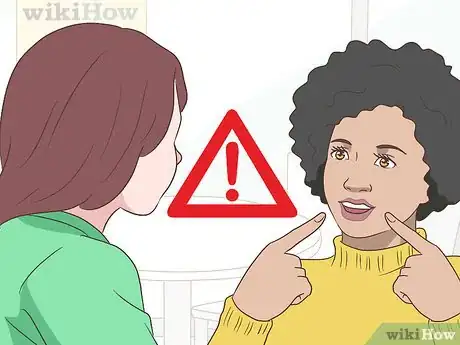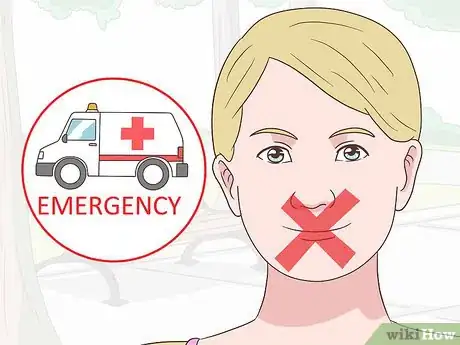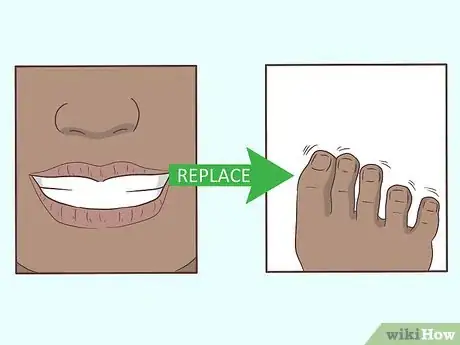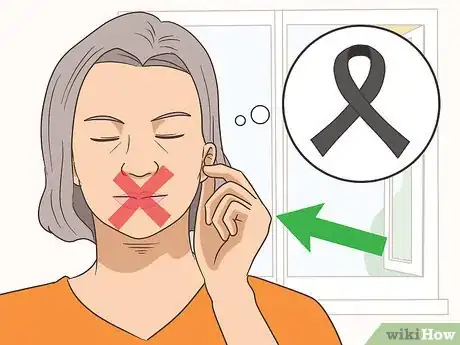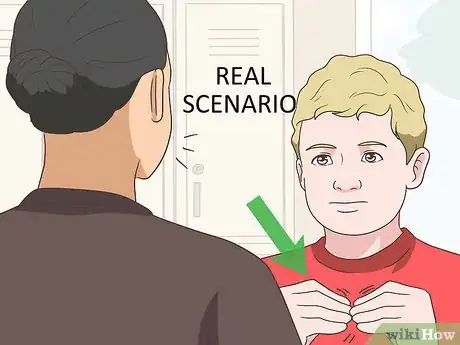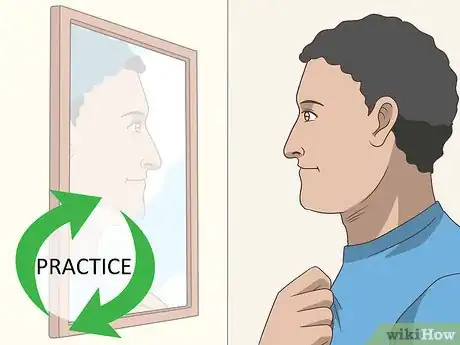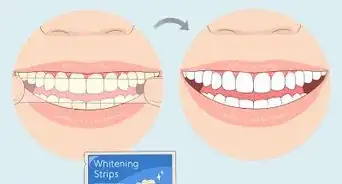This article was co-authored by Paul Chernyak, LPC. Paul Chernyak is a Licensed Professional Counselor in Chicago. He graduated from the American School of Professional Psychology in 2011.
This article has been viewed 125,017 times.
There are many reasons that people smile or laugh. Usually, people smile because they feel happy or comfortable. However, sometimes they smile when it's actually inappropriate. This is usually caused by nervousness and not knowing how to respond in a given moment. Luckily, smiling inappropriately is a habit that can be changed just like any other.
Steps
Identifying Your Smile Triggers
-
1Ask a friend if they’ve noticed your inappropriate smile. Choose someone who you’ve been in some uncomfortable situations with. These are most likely to be the times you’ve smiled inappropriately.[1]
- Even if you’re positive that you smile inappropriately, it’s good to ask a friend. They might not have noticed, or the problem may not be as bad as you think.
- You can ask your friend to keep an eye out for your inappropriate smile in the future. Make sure they know to only alert you to it afterward, in private.
- Your friend might have insight into the kinds of situations that cause you to smile inappropriately. For example, they may notice a pattern such as you smiling when someone conveys bad news or when someone hurts themselves.
-
2Notice what makes you smile inappropriately. You might already have an idea of what triggers your inappropriate smiling. Be as specific as possible in pinpointing what your personal triggers are.
- For example, instead of deciding that you smile when you feel uncomfortable, be more specific. Is it when you feel shy in front of an authority figure? Or when you feel put on the spot? Or when talking to someone you secretly find attractive? All of these situations might be uncomfortable, but the more specific you can be, the better.
- If you catch yourself smiling inappropriately, don’t beat yourself up over it. Simply take note, and remember what the scenario was so you can practice changing your behavior.
Advertisement -
3Choose the moments that you want to stop smiling. You may not want or be able to stop smiling at all uncomfortable moments. Pick one or two situations that you want to focus on while you practice not smiling.
- Your trigger may be one specific person or scenario. If this is the case, you may do best to avoid that person or scenario until you have become practiced at not smiling.
- You can choose the situation that is the hardest for you, or one that might be easier. It’s up to you. You may want to pick a scenario you’re in frequently, so you can use your new skills often.
Replacing Smiling with Another Behavior
-
1Choose a replacement behavior. A great way to change a habit is to replace it with something else. Smiling inappropriately is really just a habit, so you should be able to pick another behavior that you can do instead.[2]
- Choose something simple that others are unlikely to notice, such as biting down on your tongue, rubbing your fingers together, or wiggling your toes.
- It’s great if you can pick something that helps you deal with your feelings of discomfort. For example, if you smile when you feel under pressure, replacing the smile with silently taking three deep breaths can also help you calm down and relieve the pressure.
-
2Practice replacing a smile with the new behavior by yourself. Imagine that you’re in a scenario where you might smile inappropriately. Imagine who you would be with and what they would do or say. As you do this, practice your replacement behavior while not smiling.[3]
- If you feel comfortable, you can ask a friend or family member to role play with you and to pretend to be someone else so you can practice.
- Practice many times, until doing your replacement behavior instead of smiling becomes second nature.
-
3Try the replacement behavior in a real scenario. You may not be able to plan for this, since triggering situations tend to be unpredictable. However, you need to practice in real situations in order to fully develop your new habit.[4]
- If you still smile, and it’s not too embarrassing, you can say something like, “I’m sorry. I know it’s inappropriate that I just smiled. It’s something I’m working on. I’m not actually happy to hear the bad news.”
- Continue to practice, both at home and with other people. You can replay a real-life scenario by yourself later, if you want to practice responding differently than you did.
-
4Choose a different behavior if you need to. Not all replacement behaviors will work for you. If the one you chose isn’t working, try a new one. Practice it at home and in real scenarios, too.[5]
- A behavior may also involve saying affirmations or mantras to yourself. For example, you may need to tap your fingers together while also thinking to yourself, “I am sorry to hear what this person is going through. It’s difficult for them.”
Rewarding Yourself When You Succeed
-
1Congratulate yourself when you don’t smile inappropriately. Rewards are an important part of changing habits. You need to reward yourself every time you do a good job controlling your smile.[6]
- Tell yourself that you did a great job. It even helps to say this out loud once you’re alone.
- Physically pat yourself on the back. It may seem silly, but it’s actually effective.
- You can give yourself a more tangible reward, if you like. You can take yourself out for a nice meal or buy yourself something as a gift.
-
2Stay positive even if you mess up. No one is going to change their habits perfectly right off the bat. Accept the fact you’ll probably still smile inappropriately sometimes. Don’t beat yourself up when you slip.[7]
- Being too hard on yourself is likely to make you even more uncomfortable in tough situations. That can create a cycle of discomfort that will lead to you smiling when you don’t want to.
- Say positive affirmations to yourself, such as, “That was a good try. Next time, I’m going to do even better.”
-
3Continue to practice until you successfully change your habit. There are conflicting thoughts on how long it takes to break and reform habits. However, everyone can agree that it doesn’t happen overnight. It may take anywhere from three weeks to three months of consistent work.[8]
- If you’re doing very well with changing your habit, you can practice with more scenarios and ones that are more challenging.
-
4Let yourself smile when it is appropriate. Make sure you keep allowing yourself to smile when you actually should! Smiling is a huge way that people convey comfort, affection, and attraction. Don’t retrain yourself so much that you lose the ability to smile in an uncontrolled way.[9]
- When you’re around someone who you are attracted to but don’t want them to know it, you may want to control your smile. However, if it would be okay for them to think that you like them, let yourself smile! They will likely feel more comfortable around you.
- Even in difficult situations, smiling and laughing are ways people often deal with grief and trauma. It’s perfectly okay to smile or laugh at a funeral or other somber occasion, as long as you’re not being rude or inconsiderate.
Warnings
- Smiling inappropriately can also be a symptom of having had a stroke, or being on the autism spectrum. If someone you know smiles at what seems like the wrong time, there may be a clinical reason for it.⧼thumbs_response⧽
References
- ↑ http://www.samuelthomasdavies.com/how-to-stop-nervous-laughter/
- ↑ http://www.samuelthomasdavies.com/how-to-stop-nervous-laughter/
- ↑ http://www.samuelthomasdavies.com/how-to-stop-nervous-laughter/
- ↑ http://www.samuelthomasdavies.com/how-to-stop-nervous-laughter/
- ↑ http://www.samuelthomasdavies.com/how-to-stop-nervous-laughter/
- ↑ http://www.samuelthomasdavies.com/how-to-stop-nervous-laughter/
- ↑ http://www.samuelthomasdavies.com/how-to-stop-nervous-laughter/
- ↑ http://www.samuelthomasdavies.com/how-to-stop-nervous-laughter/
- ↑ http://www.sirc.org/publik/flirt.html
About This Article
Smiling at inappropriate times is actually a pretty normal response to feeling uncomfortable or nervous, but there are ways you can train yourself not to. When you feel the urge to smile at an inappropriate time, try to replace it with another behavior, like clenching your fist, wiggling your toes, or taking a few deep breaths. You can also practice this at home by imagining yourself in the inappropriate situation and then doing your replacement behavior. This will start to form a habit and hopefully stop you from doing it in public. If someone mentions your inappropriate smiling, just say something like, “Yeah I have a slight issue with that, sorry. I’m working on it.” For more tips from our co-author, including how to reward yourself for not smiling inappropriately, read on.
